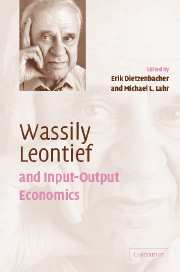Book contents
- Frontmatter
- Contents
- List of contributors
- List of figures
- List of tables
- Preface
- Part I Reflections on input-output economics
- 1 A portrait of the master as a young man
- 2 Leontief's “magnificent machine” and other contributions to applied economics
- 3 Leontief and the future of the world economy
- 4 International trade: evolution in the thought and analysis of Wassily Leontief
- 5 Leontief's input-output table and the French Development Plan
- 6 Leontief and dynamic regional models
- 7 Experiences with input-output and isomorphic analytical tools in spatial economics
- 8 Leontief and Schumpeter: a joint heritage with surprises
- 9 Some highlights in the life of Wassily Leontief – an interview with Estelle and Wassily Leontief
- Part II Perspectives of input-output economics
- Subject index
- Author index
1 - A portrait of the master as a young man
Published online by Cambridge University Press: 22 September 2009
- Frontmatter
- Contents
- List of contributors
- List of figures
- List of tables
- Preface
- Part I Reflections on input-output economics
- 1 A portrait of the master as a young man
- 2 Leontief's “magnificent machine” and other contributions to applied economics
- 3 Leontief and the future of the world economy
- 4 International trade: evolution in the thought and analysis of Wassily Leontief
- 5 Leontief's input-output table and the French Development Plan
- 6 Leontief and dynamic regional models
- 7 Experiences with input-output and isomorphic analytical tools in spatial economics
- 8 Leontief and Schumpeter: a joint heritage with surprises
- 9 Some highlights in the life of Wassily Leontief – an interview with Estelle and Wassily Leontief
- Part II Perspectives of input-output economics
- Subject index
- Author index
Summary
The Harvard background
Leontief had a long and picturesque life in three countries, on two continents. Over sixty years his was a first-rate lectureship at Harvard University and New York University (NYU). At the editors' invitation, I speak here for an early generation of Leontief's boys: those in his special workshop within a golden pre-war Cambridge age. Listed in approximate chronological order, I bear witness for Abram Bergson, Sidney Alexander, Shigeto Tsuru, Lloyd Metzler, Dick Goodwin, Jim Duesenberry, Hollis Chenery, Bob Solow and myself. A baker's half dozen that, owing only to age-related inadvertence, omits to mention a few other celebrated names.
For a long time I was as much younger than Leontief as Solow is younger than I am. However, late in the era of the Soviet Union, revisionist research into Czarist vital statistics pushed back from 1906 to 1905 the birth year of my beloved master. But what signifies age? When I first glimpsed Wassily, brown-suited, dark, scarred and handsome, at the 1934 Palmer House Chicago meeting of the American Economic Association (AEA), he looked much the same as when at 69 he left Harvard in a huff for NYU. Even in the months before he died, in 1999, his appearance had not changed much. I may also add that his foreign accent softened little over the years; but, after my first hour of hearing him lecture, his soft-spoken words came through loud and clear.
We graduate students spun legends in the junior common room about our mentor.
- Type
- Chapter
- Information
- Wassily Leontief and Input-Output Economics , pp. 3 - 8Publisher: Cambridge University PressPrint publication year: 2004
- 10
- Cited by



